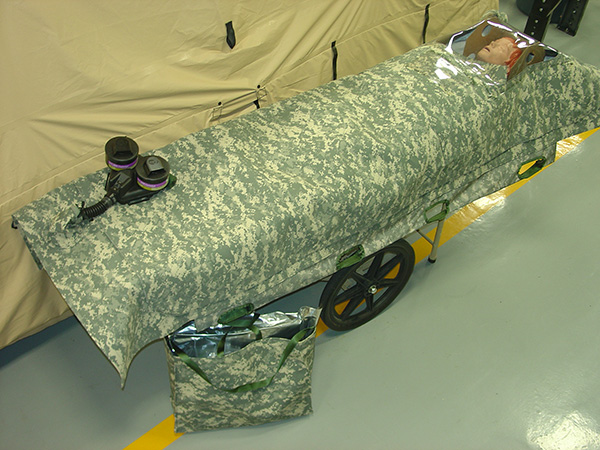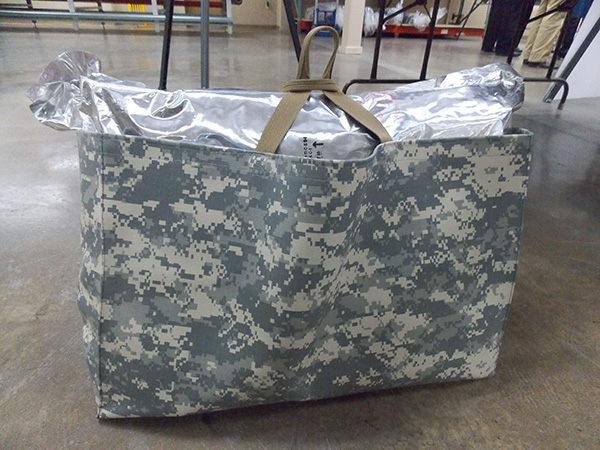Combined Patient Protective Wrap Meets Critical Need

The rapid deployment of protective gear for incapacitated Soldiers against chemical agent exposure has always been problematic. That is until the development of the Chemical Patient Protective Wrap.
The lightweight, one-size-fits-most, patient carrier bag is equipped with state of the art chemical agent repellent and even includes a personal Powered Air Purifying Respirator. These features, combined with its ultra-portability, ensure adequate individual protection is given to patients while being transported through a chemically contaminated area.
The CPPW began as a joint effort launched to secure a reliable, fixed supply source that would enhance the Army's ability to supply materials and production needs to meet a requirement of the Chemical Biological Radiological and Nuclear Healthcare mission.
"Not only does the CPPW meet a critical capability need for the deployed Warfighter, the engineering knowledge gained through the development of the CPPW can be institutionalized and utilized by [the U.S. Army Medical Research and Materiel Command] and our partners for other Army and defense efforts," said Steve Hawbecker, project manager at Medical Support Systems Project Management Offices at the U.S. Army Medical Materiel Development Activity.
At the heart of the CPPW, is a cross-departmental synergy among its stakeholders where USAMMDA and collaborators leverage resources to create a more efficient manufacturing process. USAMMDA's MSS PMO engaged the Joint Project Manager for Protection for acquisition assistance and established a Memorandum of Agreement for government production. JPM-P recommended a reverse-engineered CPPW in conjunction with an organic manufacturing base. The Pine Bluff Arsenal, in Pine Bluff Arkansas, established an organic production capability. Both efforts are currently in progress.
While the government production line is being established, a contract was awarded to procure the CPPW for a short-term commercial off-the-shelf buy. To satisfy immediate demands, the Natick Soldier Research, Development, and Engineering Center is producing 20 prototype copies based on a previous design.
"The teamwork and collaborative effort of all the stakeholders, both internal and external, has been instrumental in getting Pine Bluff Arsenal setup for success," said Justin Lieber, Project Manager at Business Operations & Planning, Pine Bluff Arsenal.
The Pine Bluff Arsenal held a VIP event to view the production line for the CPPW and discuss full-rate production including fielding and reclamation, for which all stakeholders were in attendance for.

The tour of the CPPW organic depot production demonstrated an on-demand, and expandable, assembly line to provide the capability to move non-ambulatory patients through a chemically contaminated environment. Additionally, tours were provided of the Pine Bluff Arsenal facilities for fabrication of large filters and production and shelf life extension testing laboratory to explore other joint development and production opportunities.
"The CPPW project wouldn't have been a success without the subject matter expertise of JPEO Chemical Biological Defense, Natick Soldier Research Development and Engineering Center and Pine Bluff Arsenal," said Hawbecker. "Their dedication and passion for the work they do, and the cohesion of the team focused on a singular solution, was key to the rapid engineering and manufacturing integration at Pine Bluff Arsenal."
The CPPW is employed in Battalion Level Aid Stations, Medical Treatment Squads in Medical Companies and Combat Support Hospitals. The CPPW protects patients who cannot put on personal protective clothing. It provides respiratory and skin exposure protection for unmasked, uncontaminated patients. The CPPW protects for at least six hours against exposure to several known potential chemical warfare agents in vapor, aerosol, liquid or thickened liquid form.
While manufactured in one size and weighing no more than nine pounds, excluding the Powered Air Purifying Respirator, C420 Blower, and C2A1 Filter Canisters, the CPPW is large enough to encapsulate military personnel ranging from the fifth percentile female to the 95th percentile male and bears the weight without ripping during movement.
The CPPW top layer is manufactured of a breathable laminate material, a three-layer laminate for the ground cloth, a flexible plastic film for the window at face level, and is coated entirely with a laminated chemical protective layer which protects against exposure to chemical warfare agents in vapor, aerosol, liquid or thickened liquid form.
The size of the CPPW allows for adequate space at the head to permit the use of a medical non-breathing mask supraglottic devices for airway management and cricothyroidotomy tubes for emergency airway puncture. It also accommodates patients wearing current Army issue tourniquets, splints, backboard and junctional hemorrhage control devices.
Uniquely designed so air and carbon dioxide will be exchanged through the CPPW, the carbon dioxide buildup is less than three percent by volume and oxygen level does not fall below 18 percent over a six-hour test period.
The uniquely designed interior and exterior allows patients to extricate themselves with little effort in less than one minute, and even offers the passage of intravenous and intraosseous infusion devices for injecting directly into bone marrow, and respiratory tubing.
"The advancement of the Chemical Patient Protective Wrap is a testament to the collaborative nature of the relationships between key stakeholders such as [Office of The Surgeon General], JPM Protection, NSRDEC and Pine Bluff Arsenal," said James Cromartie, logistics management specialist at the MSS PMO at USAMMDA. "The CPPW is a critical element of the AMEDD's overall chemical defense strategy and will continue to evolve in terms of capability."













